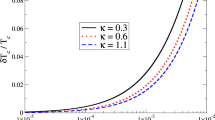Abstract
The Ginzburg–Landau model is a phenomenological description of superconductivity. A crucial feature of type-II superconductors is the occurrence of vortices, which appear above a certain value of the strength of the applied magnetic field called the first critical field. In this paper we estimate this value, when the Ginzburg–Landau parameter is large, and we characterize the behavior of the Meissner solution, the unique vortexless configuration that globally minimizes the Ginzburg–Landau energy below the first critical field. In addition, we show that beyond this value, for a certain range of the strength of the applied field, there exists a unique Meissner-type solution that locally minimizes the energy.
Similar content being viewed by others
References
Alama S., Bronsard L., Montero J.A.: On the Ginzburg–Landau model of a super-conducting ball in a uniform field. Ann. Inst. H. Poincaré Anal. Non Linéaire 23(2), 237–267 (2006)
Alberti G., Baldo S., Orlandi G.: Functions with prescribed singularities. J. Eur. Math. Soc. (JEMS) 5(3), 275–311 (2003)
Alberti G., Baldo S., Orlandi G.: Variational convergence for functionals of Ginzburg–Landau type. Indiana Univ. Math. J. 54(5), 1411–1472 (2005)
Bethuel F., Brezis H., Orlandi G.: Asymptotics for the Ginzburg–Landau equation in arbitrary dimensions. J. Funct. Anal. 186(2), 432–520 (2001)
Bardeen J., Cooper L.N., Schrieffer J.R.: Theory of superconductivity. Phys. Rev. 108, 1175–1204 (1957)
Baldo S., Jerrard R.L., Orlandi G., Soner H.M.: Convergence of Ginzburg–Landau functionals in three-dimensional superconductivity. Arch. Ration. Mech. Anal. 205(3), 699–752 (2012)
Baldo S., Jerrard R.L., Orlandi G., Soner H.M.: Vortex density models for superconductivity and superfluidity. Comm. Math. Phys. 318(1), 131–171 (2013)
Bethuel F., Orlandi G., Smets D.: Vortex rings for the Gross-Pitaevskii equation. J. Eur. Math. Soc. (JEMS) 6(1), 17–94 (2004)
Chiron D.: Boundary problems for the Ginzburg–Landau equation. Commun. Contemp. Math. 7(5), 597–648 (2005)
Contreras A.: On the first critical field in Ginzburg–Landau theory for thin shells and manifolds. Arch. Ration. Mech. Anal. 200(2), 563–611 (2011)
De Gennes P.G.: Superconductivity of Metals and Alloys. Advanced book classics, Perseus, Cambridge, MA (1999)
Fournais S., Helffer B.: Spectral methods in surface superconductivity, Progress in Nonlinear Differential Equations and their Applications, vol. 77. Birkhäuser Boston, Inc., Boston, MA (2010)
Fournais S., Kachmar A.: The ground state energy of the three dimensional Ginzburg–Landau functional Part I: Bulk regime. Comm. Partial Differential Equations 38(2), 339–383 (2013)
Fournais S., Kachmar A., Persson M.: The ground state energy of the three dimensional Ginzburg–Landau functional. Part II: Surface regime. J. Math. Pures Appl. (9) 99(3), 343–374 (2013)
Ginzburg, V.L., Landau, L.D.: On the theory of superconductivity, Zh. Eksp. Teor. Fiz. 20 (1950), 1064–1082. English translation in: Collected papers of L.D.Landau, Edited by D. Ter. Haar, Pergamon Press, Oxford 1965, pp. 546–568
Giorgi T., Phillips D.: The breakdown of superconductivity due to strong fields for the Ginzburg–Landau model. SIAM J. Math. Anal. 30(2), 341–359 (1999)
Jerrard R.L.: Lower bounds for generalized Ginzburg–Landau functionals. SIAMJ.Math. Anal. 30(4), 721–746 (1999)
Jerrard R., Montero A., Sternberg P.: Local minimizers of the Ginzburg–Landau energy with magnetic field in three dimensions. Comm. Math. Phys. 249(3), 549–577 (2004)
Kozono H., Sohr H.: New a priori estimates for the Stokes equations in exterior domains. Indiana Univ. Math. J. 40(1), 1–27 (1991)
London F.: Superfluids, Structure of matter series. Wiley, New York (1950)
Lin F.-H., Rivière T.: A quantization property for static Ginzburg–Landau vortices. Comm. Pure Appl. Math. 54(2), 206–228 (2001)
Lin F., Rivière T.: Complex Ginzburg–Landau equations in high dimensions and codimension two area minimizing currents. J. Eur. Math. Soc. (JEMS) 1(3), 237–311 (1999)
Rivière, T.: Line vortices in the U(1)-Higgs model, ESAIM Contrôle Optim. Calc. Var. 1 (1995/96), 77–167
Román, C.: Three dimensional vortex approximation construction and \({\varepsilon}\)-level estimates for the Ginzburg–Landau functional, Arch. Ration. Mech. Anal. 231(3), 1531–1614 (2019). https://doi.org/10.1007/s00205-018-1304-7
Serfaty S.: Local minimizers for the Ginzburg–Landau energy near critical magnetic field. I. Commun. Contemp. Math. 1(2), 213–254 (1999)
Serfaty S.: Stable configurations in superconductivity: uniqueness, multiplicity, and vortex-nucleation. Arch. Ration. Mech. Anal. 149(4), 329–365 (1999)
Sandier E., Serfaty S.: Global minimizers for the Ginzburg–Landau functional below the first critical magnetic field. Ann. Inst. H. Poincaré Anal. Non Linéaire 17(1), 119–145 (2000)
Sandier E., Serfaty S.: Ginzburg–Landau minimizers near the first critical field have bounded vorticity. Calc. Var. Partial Differential Equations 17(1), 17–28 (2003)
Sandier E., Serfaty S.: Vortices in the magnetic Ginzburg–Landau model, Progress in Nonlinear Differential Equations and their Applications, vol. 70. Birkhäuser Boston, Inc., Boston, MA (2007)
Sandier E., Shafrir I.: Small energy Ginzburg–Landau minimizers in \({{\mathbb{R}}^3}\). J. Funct. Anal. 272(9), 3946–3964 (2017)
Tinkham M.: Introduction to superconductivity, Second. McGraw-Hill, New York (1996)
Xiang X.: On the shape of Meissner solutions to a limiting form of Ginzburg–Landau systems. Arch. Ration. Mech. Anal. 222(3), 1601–1640 (2016)
Acknowledgements
I am very grateful to my former Ph.D. advisors Etienne Sandier and Sylvia Serfaty for suggesting the problem and for useful comments. I also thank the anonymous referees for helpful comments. Most of this work was done while I was a Ph.D. student at the Jacques-Louis Lions Laboratory of the Pierre and Marie Curie University, supported by a public grant overseen by the French National Research Agency (ANR) as part of the “Investissements d’Avenir” program (reference: ANR-10-LABX-0098, LabEx SMP). Part of this work was supported by the German Science Foundation DFG in the context of the Emmy Noether junior research group BE 5922/1-1.
Author information
Authors and Affiliations
Corresponding author
Ethics declarations
The author declares that they have no conflict of interest.
Additional information
Communicated by R. Seiringer
Publisher’s Note
Springer Nature remains neutral with regard to jurisdictional claims in published maps and institutional affiliations.
Rights and permissions
About this article
Cite this article
Román, C. On the First Critical Field in the Three Dimensional Ginzburg–Landau Model of Superconductivity. Commun. Math. Phys. 367, 317–349 (2019). https://doi.org/10.1007/s00220-019-03306-w
Received:
Accepted:
Published:
Issue Date:
DOI: https://doi.org/10.1007/s00220-019-03306-w



